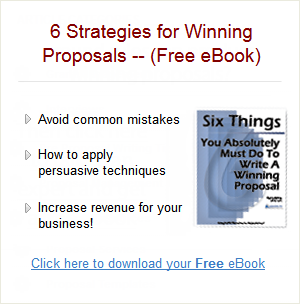How Does the Customer Evaluate Proposals?
It’s impossible to give a description of how each evaluation process works; every firm and agency that evaluates proposals has its own way of doing it. But it is possible-and very useful-to explain a few things about proposal evaluation in general.
For any given procurement, the customer receives a pile of proposals in response to his solicitation. His next move is to begin sifting through the proposals. And what do you think he is doing as he evaluates? Is he selecting a winner? Is he reading each of the documents one after the other in order to find the one that leaps out at him?
No. What he is really doing is what we all do when we make a decision; he starts off by eliminating the ones that do not measure up to the standards.
Evaluating a proposal, then, is really a process of elimination, rather than a process of selection. That’s why when you write your proposal you ought to be focused not on writing a proposal that will be selected. You should instead focus on WRITING A PROPOSAL THAT CANNOT BE ELIMINATED!
You must be aware of this as you write your proposal. You need to write it in such a way that there is no possibility that the evaluator can toss it into the reject pile, not at the beginning of the evaluation nor at any time during the process as the pile of “keepers” grows smaller and smaller.
Here’s how you can do this:
You need to respond to each and every requirement in the solicitation. This makes it impossible for the client to reject you for being “non-responsive to the RFP.”
You need to make sure that your proposal offers a solution that will solve the problem at hand at least as well as any other. This makes it impossible for the client to reject you for not being as qualified or as competent to do the job as the rest of the field.
You need to make sure that you call out the clear and direct benefits of your proposed solution. This makes it impossible for the client to reject your approach on the grounds that it does not add value, or that it does not meet all the client’s concerns-even those unspecified in the solicitation.
At some point in the evaluation, usually when it’s down to the last two or three proposals, the client does make a decision. He selects yours over the other firm’s. But he does so because he has tried to eliminate yours (and theirs) throughout the process and simply cannot do it. By this time you have pounded the benefits of your approach into his head for so long that he simply could not consider rejecting your proposal.
There is a big difference between writing a proposal to be selected as the winner and writing one that can’t be eliminated. When you write to avoid being eliminated, you begin to think of all that it takes to meet that single objective. In other words, you begin think about writing the proposal from the standpoint of the reader.

